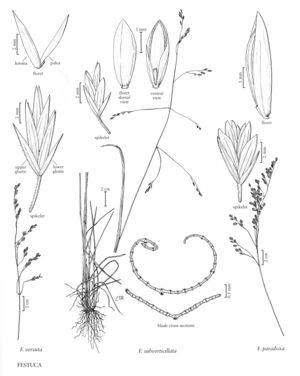Festuca versuta
Plants loosely cespitose, without rhizomes. Culms 50-100 cm, glabrous, somewhat glaucous; nodes usually exposed. Sheaths closed for less than 1/3 their length, glabrous or sparsely pubescent, shredding into fibers; ligules 0.5-1 mm; blades 2-10 mm wide, flat, loosely conduplicate, or involute, abaxial surfaces smooth or scabrous, glabrous or puberulent, adaxial surfaces smooth or scabrous, veins 13-35, ribs obscure; sclerenchyma in abaxial and adaxial strands; girders formed at most major veins. Inflorescences (8)10-30(40) cm, open, with 1-2 branches per node; branches lax, spreading, spikelets borne towards the ends of branches. Spikelets 6-11 mm, sometimes glaucous, with (2)3-5 florets. Glumes lanceolate, smooth or scabrous, acuminate; lower glumes 4-7 mm; upper glumes 5-7.5 mm; lemmas 5-8 mm, chartaceous, lanceolate, glabrous, usually smooth, sometimes scabrous towards the apices, apices acute to acuminate, unawned, sometimes mucronate; paleas as long as or slightly shorter than the lemmas, intercostal region puberulent distally; anthers 2-3 mm; ovary apices densely pubescent. 2n = unknown.
Distribution
Kans., Tenn., Ark., Okla., Tex.
Discussion
Festuca versuta grows in moist, shaded sites on rocky slopes in open woods, from Oklahoma and Arkansas to Texas. It is an uncommon species.
Selected References
None.
